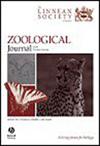巴尔干半岛棘足虫属(蛛形纲:棘足虫属)染色体变化的进化动力学
IF 2.8
2区 生物学
Q1 ZOOLOGY
引用次数: 0
摘要
本文研究了蛛形纲蛛形目蛛形目亚目蛛形目蛛形目蛛形目蛛形目蛛形目蛛形目蛛形目蛛形目蛛形目蛛形目蛛形目的细胞遗传学演变。我们对21个物种的综合分析显示,在二倍体染色体数目上有显著的差异(2n = 24-30),挑战了之前关于该群体遗传一致性的假设。使用荧光原位杂交(FISH)和18S rDNA探针,我们检测到位点数量的变化,有证据表明该簇中有独立的增加(多达5对)。本研究将基于线粒体基因细胞色素c氧化酶亚基I (COI)(包括核型个体)分析的系统发育重建结果与标准和分子细胞遗传学技术相结合,在收割机研究中尚属首次。研究结果表明,巴尔干半岛的生物多样性水平明显高于之前的认识,表明Cyphophthalmus属内部存在复杂的分化。此外,我们的研究结果强调了细胞遗传学作为物种描述工具的功效,丰富了我们对属进化历史的理解,并强调了巴尔干半岛独特的地质和环境历史塑造的复杂遗传多样性。本文章由计算机程序翻译,如有差异,请以英文原文为准。
Evolutionary dynamics of the chromosomal changes in the genus Cyphophthalmus (Arachnida: Opiliones) on the Balkan Peninsula
We investigated the genus Cyphophthalmus within the suborder Cyphophthalmi (Arachnida: Opiliones), focusing on its cytogenetic evolution in the Balkan Peninsula. Our comprehensive analysis of 21 species revealed a notable range in diploid chromosome numbers (2n = 24–30), challenging previous assumptions of genetic uniformity within this group. Using fluorescent in situ hybridization (FISH) with an 18S rDNA probe, we detected variability in the number of loci, with evidence of independent increases in this cluster (up to five pairs). This study combines the results of phylogenetic reconstruction based on analysis of mitochondrial gene cytochrome c oxidase subunit I (COI) (including karyotyped individuals) with standard and molecular cytogenetic techniques, making it the first of its kind in harvestman research. The findings reveal a significantly higher level of biodiversity in the Balkan Peninsula than previously recognized, suggesting complex differentiation within the genus Cyphophthalmus. Additionally, our results highlight the efficacy of cytogenetics as a tool for species’ delineation, enriching our understanding of the evolutionary history of the genus and emphasizing the intricate genetic diversity shaped by the unique geological and environmental history of the Balkan Peninsula.
求助全文
通过发布文献求助,成功后即可免费获取论文全文。
去求助
来源期刊
CiteScore
6.50
自引率
10.70%
发文量
116
审稿时长
6-12 weeks
期刊介绍:
The Zoological Journal of the Linnean Society publishes papers on systematic and evolutionary zoology and comparative, functional and other studies where relevant to these areas. Studies of extinct as well as living animals are included. Reviews are also published; these may be invited by the Editorial Board, but uninvited reviews may also be considered. The Zoological Journal also has a wide circulation amongst zoologists and although narrowly specialized papers are not excluded, potential authors should bear that readership in mind.

 求助内容:
求助内容: 应助结果提醒方式:
应助结果提醒方式:


